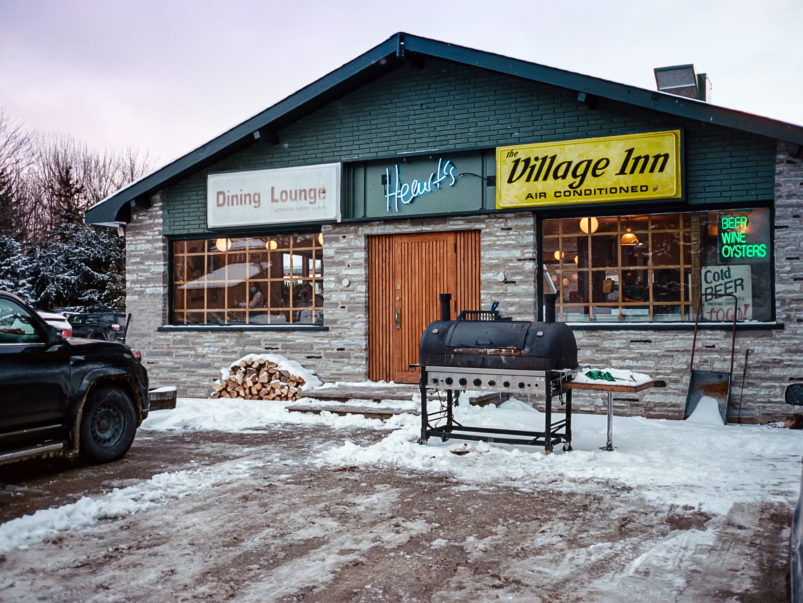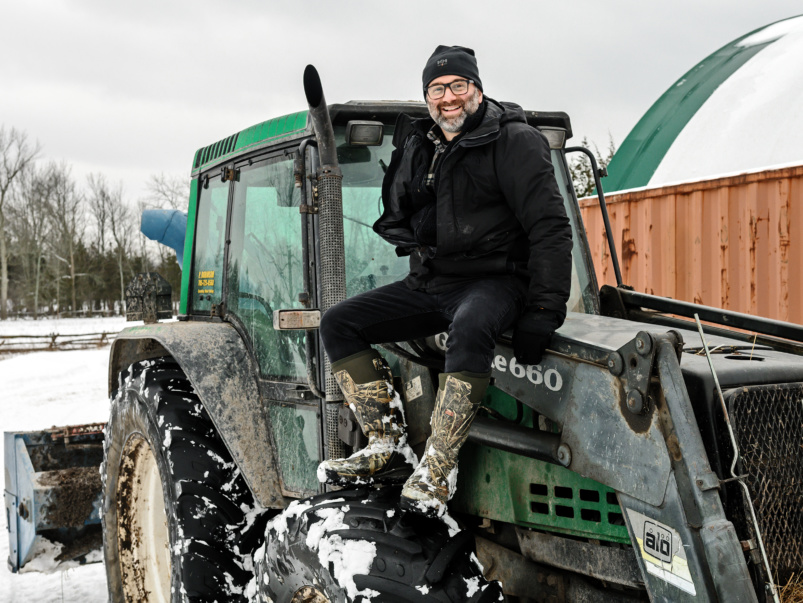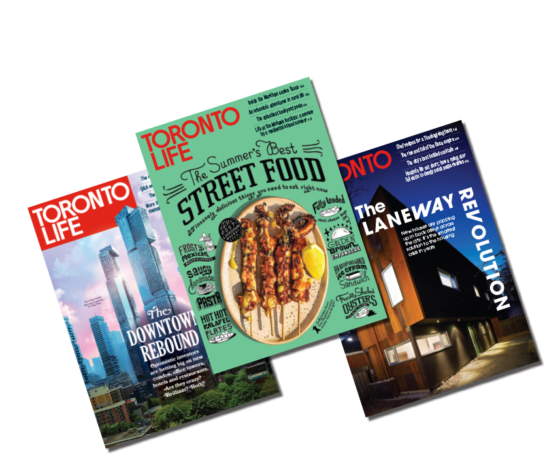“We came really close to selling the place”: Two Toronto restaurateurs on the struggle to open their dream Grey County restaurant

In October 2018, Teo Paul and Tyler Wilson—the team behind Ossington’s Union and Côte de Boeuf—bought a dilapidated tavern in the Grey County village of Kimberley. The dream was to open a new restaurant that would stretch their brand beyond Toronto’s city limits, with a new feel evocative of a European roadside tavern. But with a pandemic just around the corner, and a steep learning curve during the build, the project was so difficult that they almost sold it a week before opening. Now, Heart’s is open to ringing praises from both locals and the droves of Torontonians who make the drive up. Here’s how they pulled it off.
Teo: My family has had a farm in Grey County for 30 years—it’s where I spent weekends growing up. In the ’80s, the building was a popular tavern called the Village Inn. So it’s been in the community for a long time.
Tyler: We first saw that it was up for sale in 2016. We went to check it out, and it was in bad shape—think black mold, raccoons and rats. But we saw its potential. It’s on a hill, on an acre and a half of land surrounded by greenery, with a big garden and space for chickens.
Teo: I wasn’t actively looking to open a new restaurant, but the decision to buy it felt really organic. I started envisioning a space that felt like a roadside tavern in a place like Piedmont. Those family run-spots that blow you away with their food and wine, but have a calm, unpretentious vibe. It took us until 2018 to actually buy it, since there was a family dispute about its ownership. And when it came to renovating, we had this idea that it would be easier in the country for some reason. Not so, it turns out.


Tyler: For two years straight, I would go up there every Tuesday morning, come back Friday or Saturday, work at Union over the weekend, and then head back north. I spent the first month just throwing stuff out—I don’t know how many dumpsters we went through.
Teo: The house was built in the late 1800s, and we gutted it pretty much down to the studs. In December 2019, after we had been building for a year, we realized we had to find a way to make it more cost effective. It came to the point where the cost of everything that had been finished up to that point was more profound than the builders had assumed. We basically had to stop, regroup and think about how we could do this on more of a budget.
Tyler: We’re a small business, and we don’t have endless cash to put in. It was a huge learning process. I learned this: do your due diligence. Instead of getting one person to come in and give you a price, get four estimates instead. Not to say everyone takes advantage, of course, but I wish we had shopped around more at the beginning. We were city boys that got taken for a ride before we found key people we could trust.



Teo: By the end of 2019, the house had been framed and plugged, and there was a small amount of electrical roughing in. We still had to do full electrical, plumbing, insulation and drywall. And there was very little money to do that. I started feeling the pressure.
Tyler: When the pandemic hit, I moved up there, into a small bunkie on the property. I sometimes felt privileged to be up there, away from the city. I spent a lot of time outside with my dog Dylan, who by the way, is best friends with Teo’s dog, Lindy.
There were pandemic-related labour delays, but thankfully, we already had a lot of the building materials, and we had locked in prices for electrical, HVAC, and plumbing—it would have been much more expensive otherwise. We re-insulated and put a new extension on the side, but we kept the original thick hardwood floor with its orange-y colour. We had to strip down eight layers of flooring to get to it. We also used some of the original hemlock in the walls, where plywood would be today, and sanded it down to its original form.



Teo: At the time, Union was closed, and we weren’t in a huge rush to open a new restaurant when we didn’t even know when we could serve people at the new one. But we had a breakthrough when we accidentally found a wine cellar while pulling up the floorboards. That was a feel-good moment when I thought: Everything is going to be okay. The place is revealing itself to us, and it will become what it needs to be.
Tyler: Another saving grace was in January, 2021. Through my woodworker friend Daren Johnson, we tapped into an amazing group of local guys who run farms in the warmer seasons and do contracting work in the winter. A crew of them came in to finish the trim, put down the floors, hang the doors and basically do all the finishing touches.
Teo: The restaurant was mostly done, but a few months before we opened in October, we had a really dark moment. We were running out of cash to finish the project, and suddenly ran into an issue with the engineers, who wouldn’t sign off on the project. Fixing it would have been extremely expensive—so much so that we came really close to selling the place. We lucked out and brought in an excellent engineer who not only signed off on it, but didn’t charge us a dime. And he’s no slouch—he’s just as strict as the ones who wouldn’t sign off on the space, but just got what we were doing in a different way.
But every restaurant has a moment like that. In my experience building restaurants, it always comes down to the last minute, and something shifts. Every single time. I think everyone experiences issues like this when they build restaurants.


Tyler: We opened on a Thursday afternoon in April, 2021. One of the things Covid gave us was the ability to open the restaurant in stages and wow people a little bit at a time. When we first opened, we were just offering takeout from the front tavern. From there, we opened up the side patio, a back patio and we finally were able to open the main dining room to guests in October.
Teo: The food is tavern style—things people may not expect to have there—and a high-level wine program. We have a smokehouse—we’re smoking a lot of salmon—and a big meat locker with lots of cured meats. We’re planning on getting chickens in the spring. We have a big garden where we’re planning on growing beets, squash, lettuce, kale, onions and garlic. Suppliers are pretty accessible in Grey County, but you have to streamline and simplify—there isn’t as much choice as there is in Toronto. In that sense, it’s less stressful in terms of ordering. It’s humbling in a great way.
Tyler: Compared to Union, which is a well-oiled machine, there’s a lot more figuring things out day to day at Heart’s. It’s not busy every day—you just don’t know what to expect. We might have a weird quiet Saturday, or an unusually busy weekend for no apparent reason. The vibe is slower, less frantic. We don’t have a lineup at the door. Sometimes I tell the kitchen: drop what you’re doing, look outside and remember you’re in the country. Relax.


Teo: My friend Josh Hall—who helped design Union and Cote de Boeuf—worked closely with Tyler and I on the design of Hearts. What gets lost when projects go sideways is the pure dreaming, excitement and joy in building something you all believe in. At a certain point, the project got so stressful that we nearly lost touch with all that. There’s still lots to be done and we hope to get that joy back now that we are up, running and stable. The three of us are getting back on track, and working on rekindling the sense of cohesiveness and teamwork we had at the start.
As for our staff, it’s a nice mix of Toronto transplants and locals. The same goes for our customers. We’re getting a mix of curious locals and people from Toronto who are familiar with Union and Cote de Boeuf. Bringing those people up was part of the plan.
Tyler: Teo created a brand and of course, part of the success is the draw from that brand.
Teo: It was a real labour of love. We accomplished what we were after: when you walk in Heart’s, you feel like you can be anywhere in the world. You’re not stressed. The energy is calm. It’s a tavern on a beautiful hillside, and it’s only going to get better.
We have a plaque on the wall dedicated to my friend Doug Sheridan, who passed away in a snowmobile accident last February. He was a total force of nature. He had a machine shop and fixed everything for everyone—he made the window for our butcher counter at Heart’s. Everyone loved him. When older locals come in, they tell stories about Doug. That makes me feel good. It’s a good place. A heartfelt place. Like Union and Cote de Boeuf, I trust that it will become what it needs to be.
Heart’s, 235334, Grey County Rd 13, Kimberley, heartsgreycounty.ca, @hearts_greycounty














